

Guided Meditations – Mindfulness for Teens. You can practice with these guided meditation recordings from this website, or download them onto your portable device.
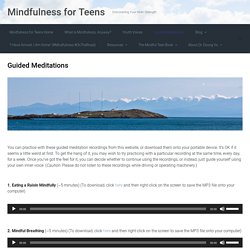
It’s OK if it seems a little weird at first. To get the hang of it, you may wish to try practicing with a particular recording at the same time, every day, for a week. Once you’ve got the feel for it, you can decide whether to continue using the recordings, or instead, just guide yourself using your own inner voice. Managing BIG Emotions: Take 5 Breathing. Today I am excited to team up with the lovely Leonie MacDonald of Relax Kids Canberra to bring you part four of the Managing Big Emotions printable poster series (you can find poster one here, poster two here and poster three here).
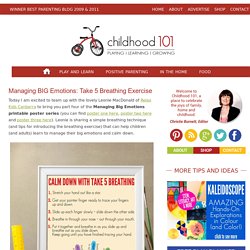
How to Breathe - For Kids! - Left Brain Buddha. A few years ago, while my daughter was in the midst of a four-alarm meltdown, I implored her to “I don’t know HOW!!”

She yelled back. At first I was dumbfounded. What do you mean, you don’t know how to breathe?? You’ve been breathing your whole life!! But she was right. The first time I tell my students to “take a deep breath,” they respond with a collective, desperate, and panicked inhale that sounds more like hyperventilation than relaxation. MINDFULNESS FOR CHILDREN. Mindful awareness exercises help children develop concentration and self-awareness.
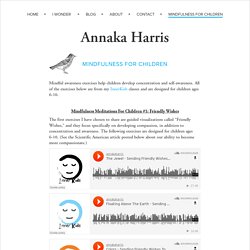
All of the exercises below are from my InnerKids classes and are designed for children ages 6-10. Mindfulness Meditations For Children #1: Friendly Wishes The first exercises I have chosen to share are guided visualizations called “Friendly Wishes,” and they focus specifically on developing compassion, in addition to concentration and awareness. The following exercises are designed for children ages 6-10. (See the Scientific American article posted below about our ability to become more compassionate.) Spider-Man: Practicing Mindfulness and Increasing Focus. Here’s a Spider-Man Script for you to try out with your children or students to practice mindfulness and increase focus.
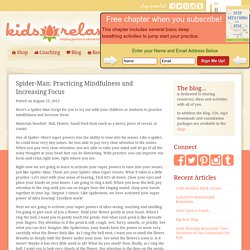
Materials Needed: Bell, Flower, Small Food Item (such as a berry, piece of cereal, or raisin) One of Spider-‐Man’s super powers was the ability to tune into his senses. Like a spider, he could hear very tiny noises. He was able to pay very close attention to the noises. When you pay very close attention, you are able to calm your mind and let go of all the noisy thoughts in your head that can be distracting.
Daniel Goleman: Breathing Buddies. 7 Fun Ways To Teach Your Kids Mindfulness. I taught a mindfulness class at my daughters’ elementary school this week.
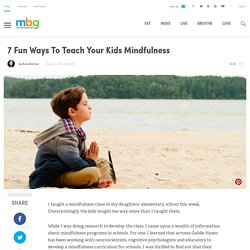
Unsurprisingly, the kids taught me way more than I taught them. Effectiveness of the Mindfulness in Schools Programme: non-randomised controlled feasibility study. Anxiety in Kids: How to Turn it Around and Protect Them For Life - Hey Sigmund - Karen Young. Anxiety is a normal response to something dangerous or stressful.
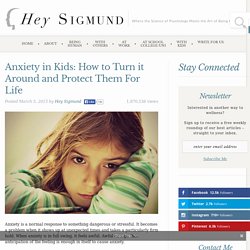
It becomes a problem when it shows up at unexpected times and takes a particularly firm hold. When anxiety is in full swing, it feels awful. Awful enough that anticipation of the feeling is enough in itself to cause anxiety. We already know that anxiety has nothing to do with strength, courage or character. It picks a target and it switches on. When that target is a child or teen, it can be particularly distressing, causing problems with sleeping, eating and missed school from unexplained illnesses such as sick tummies or headaches. One of the worst things about anxiety is the way it can happen without any identifiable cause.
The good news is that anxiety in kids is very treatable and they are particularly responsive. Susan Kaiser Greenland - Home. Ness and Learning: What’s the Connection? Photo © iStockPhoto.com/kate_sept2004.
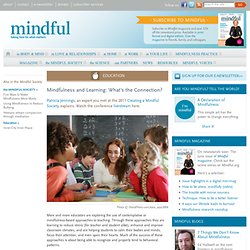
Why Teaching Mindfulness Benefits Students’ Learning. Teaching Strategies Flickr:Sudhamshu The following is an excerpt from Learning to BREATHE: A Mindfulness Curriculum for Adolescents to Cultivate Emotion Regulation, Attention, and Performance By Patricia C.

Broderick, PhD What do children and adolescents need to be successful in life? There is little doubt that in addition to academic success, we also want our youth to be happy and well. These goals are far from being disconnected: we now realize the fundamental role that social and emotional well-being play in the attainment of academic outcomes. Although the emphasis on academic achievement often captures most of the attention in debates on school reform, important inroads are being made by those who take a more holistic approach to education. Many prominent voices have joined together to call for inclusion of social and emotional learning within K–12 school curricula.
[RELATED: The Importance of Teaching Mindfuless] When feelings are not well managed, thinking can be impaired. 1. 2. 3. Low-Income Schools See Big Benefits in Teaching Mindfulness. Teaching Strategies On his first day teaching at Coronado Elementary School in Richmond, Calif., students threw rocks at Jean-Gabrielle Larochette, pretending he was a police officer.

He spent fifteen minutes of every class calming down a handful of kids in this low-income-neighborhood public school who wouldn’t follow directions or behave. Larochette began practicing meditation and mindfulness to cope with his own stresses of teaching and supporting traumatized kids. He believed the breathing techniques that helped calm his fears might work for his students too, so he founded the Mindful Life Project. “Before we can teach a kid how to academically excel in school, we need to teach him how to have stillness, pay attention, stay on task, regulate, make good choices,” said Larochette. A Documentary Film about Transformation through Mindfulness Meditation in Public Schools. Mind Jar. A “Mind Jar” is a relatively simple tool for helping kids (and adults) appreciate mindfulness.
This past week I offered some suggestions to the school counselors for the local district and I made some mind jars to share. A few participants asked for the recipe, so I promised I would post it here! A Mind Jar can be shaken, and it is filled with glitter. The glitter represents how busy our mind and body can be with thoughts and physical sensations, such as anxiety and worrisome thoughts. For kids, shaking up the mind jar is way of expressing how they feel. After a few minutes, the jar looks more like this: Pretty cool! So, what’s the trick? Choose your container(s) and heat enough water to fill the container almost to the top (quite hot water, but not boiling). Now here is the in-exact science of it: Put the lid on tight after you’ve poured your mixture over into the mind jar container.